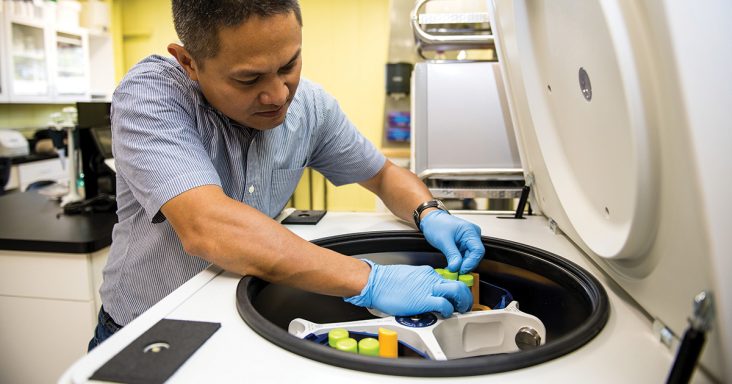New approach helps expedite detection of costly plant viruses
by September 12, 2023 3:00 pm 441 views

Scientists with the Arkansas Clean Plant Center at the Arkansas Agricultural Experiment Station, the research arm of the University of Arkansas System Division of Agriculture, have developed a protocol that speeds up the process, lowers the cost and improves the accuracy of detecting plant viruses.
Ioannis Tzanetakis, director of the Arkansas Clean Plant Center and professor of plant virology, said a major bottleneck in detecting pathogens is the availability of positive controls to confirm a diagnosis. A positive control is a specimen known to contain the pathogen in question. Acquiring positive controls can be problematic, and their maintenance is expensive, and without them, a test cannot be validated, he said.
“This is a clear case of necessity being the mother of invention,” Tzanetakis said. “We had a new plant virus in Europe but nothing here to compare it to. What is unique about our approach is that because we are using a ‘sister’ virus as the surrogate, everything that we do pretty much mimics a natural infection and we do not need to import the infected material.”
Plant viruses cause billions of dollars of losses in agricultural crops worldwide, affecting the yield and quality of agricultural products, according to the U.S. Department of Agriculture. The emergence of novel viruses or variants through genetic evolution and spillover from reservoir host species, changes in agricultural practices, mixed infections with disease synergism, and impacts from global warming pose continuous challenges for the management of epidemics resulting from emerging plant virus diseases, the USDA reported.
The USDA has strict restrictions on the movement of plant material from outside the country, Tzanetakis said. And while there are permits for laboratories to conduct diagnostics with diseased material, the process is lengthy. So, what’s a scientist to do when time is of the essence in obtaining a positive control? Mimic it, said Tzanetakis.
A benefit of the patent-pending process, Tzanetakis noted, is that it can tell if the virus is from an unintentional contamination.
The Clean Plant Center works with plant material from all over the world, making sure plants are free from viruses. The scientists at the center provide virus “clean-up” and testing making sure that plant material is the best quality possible before providing it to nurseries, breeding companies and growers.
The Clean Plant Center receives plant samples from breeders, nurseries and growers to test for the presence of viruses. If scientists detect a potential virus, they must validate the detection by comparing the viral material from the plant with something that is known to contain the virus — either a “true” positive control or an “artificial” control. Normally, the Clean Plant Center obtains an artificial piece of DNA with the virus sequence as a positive control to amplify using polymerase chain reaction, also known as PCR, and compare to their diagnostics. But that process has major drawbacks, Tzanetakis said.
The center’s patent-pending protocol for virus-mimicking artificial positive controls, or ViMAPCs, creates an artificial positive control that acts like the target virus and allows for validation through what is considered a natural infection. Tzanetakis said for the “sister virus” to better imitate natural infection, it must belong to the same genus as the target virus.
“The virus-mimicking artificial positive control allows the center to create an artificial positive control that not only mimics the titre and tropism of the target virus, but also is cheap and rapid compared to the currently available artificial positive controls,” said Shivani Singh, a co-inventor of the technology and program associate for the center.
Titre is the concentration of a substance in solution – in this case the concentration of virus in the plant – and tropism refers to the distribution of the virus within the plant. A positive control considered to have a “natural infection” allows for a more accurate comparison to the diagnostic than a synthetic piece of DNA, Tzanetakis added.
“With just a piece of DNA, you don’t really know if the virus you are testing for has the same titre in the tissue,” Tzanetakis explained. “Some viruses hide in the roots, and they are barely detectable in the leaves and vice versa. We have developed a protocol that is as close to natural infection as you can get unless you have the actual infection of the target virus.”
The protocol was also designed so the ViMAPC control is easily differentiated from a true infection.
“The way that we use this protocol, we can easily identify if a positive result is due to an infection in the plant or a lab-based contamination from our controls, because the controls always have a different size than what the targets will be,” Tzanetakis said, referring to gel electrophoresis, which separates DNA by size.
The newly developed approach takes less than five days to implement whereas alternatives normally take several weeks. The strategy, Tzanetakis said, is straightforward and can be done by laboratories that use polymerase chain reaction-based diagnostics. The process could also have the potential to accurately confirm viruses that impact humans, he said.
Tzanetakis said they use widely available viruses as surrogates to the ones they are targeting, and the protocol limits the need to move viral tissue across international borders.
